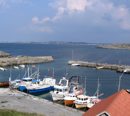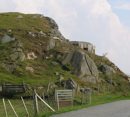Spent the weekend in Kanghwa-do with a friend. I have never been one for the usual tourist destinations so many of the highlights of the island listed in tourist brochures went unseen. The highlight for me was the hike on the first day through some hills on a small country road in the south of the island, through some farmers’ fields and along the southern coast of the island to a popular beach. Since the island is so close to North Korea, the coastline was actually a military restricted area but we walked unmolested along most of it. A man on a bicycle passing by told us it was restricted but we learned from soldiers at the next checkpoint that he was a high ranking officer out on a bike ride. When we told the biker/officer we were trying to walk along the coast to the beach, he let the soldiers further down the path know that we were harmless and to let us through. The many empty checkpoints and observation boxes along the coast had human shaped plastic scarecrows that could be set up to look like people were manning the positions.
We ended up not climbing any of the hills on the island, which in any case average around 350 meters. I’m actually glad, the hordes of other climbers, all clad in standard Korean hiking uniforms and equipment reminded me of climbing on Halla-san in Cheju-do where we essentially stood in line to get up the mountain behind hundreds of people (including groups of women sweating through their heavy make-up). Much more enjoyable was the wonderful and quiet stroll along forested country roads we got on Saturday afternoon when a local told us how to get through the hills to the coast the fastest way by an older road not marked on many maps. I recommend these country strolls in Korea as a wonderful alternative to the industrial tourist staircase that is so much hiking in Korea. You can often find yourself behind so many mountaineers you might have guessed you were on a subway stairway at rush hour if it weren’t for the fact that everyone is wielding useless metal poles and carrying plastic mats to keep the rear of their expensive and fashionable hiking pants from getting any dirt on them when they sit down.
A few places that got saved on my GPS from the weekend:





